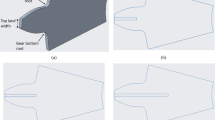Summary
In standard gear pairs there is typically a discrepancy between the bending strength of the pinion and the wheel, with the pinion being the weakest. Smaller pinion tooth numbers, typical of automotive gearing, further increase this problem and different optimised design solutions, based on long addendum modifications, have been proposed by the American Gear Manufacturers Association (AGMA) and the German organisation for gear research Forschungsstelle für Zahnräder und Getriebebau (FZG). AGMA favours a compromise between the strength of the pinion and the wheel (balanced bending strength), while FZG strengthens both pinion and wheel using bigger addendum modifications and a correspondingly bigger centre distance (maximum bending strength with balanced sliding velocities). A comprehensive comparison of the two methods does not exist in the literature because the shifting employed by the FZG recommendation exceeds the normal tabulated J-factor ranges and, because of the large number of design variables involved (i.e., number of teeth, pinion and wheel shift etc.). This paper uses non-dimensional modelling to decrease the number of independent design variables in conjunction with Boundary Element Analysis and photoelasticity measurements to compare the bending strength of all AGMA and FZG designs in the region of their intended use.
Similar content being viewed by others
References
Townsend D. P. (1992). Dudley's gear handbook. McGraw-Hill, New York
AGMA 2101-C95: Fundamental rating factors and calculation methods for involute spur and helical gear. American Gear Manufacturers Association 1995.
AGMA Information Sheet 908-B89: Geometry factors for determining the pitting resistance and bending strength of spur, helical and herringbone gear teeth. American Gear Manufacturers Association, 1989.
AGMA standard 218.01: Rating the pitting resistance and bending strength of spur and helical involute gear teeth. American Gear Manufacturers Association 1982.
AGMA standard 2001-B88: Fundamental rating factors and calculation methods for involute spur and helical gear teeth. American Gear Manufacturers Association 1988.
Lewis, W.: Investigation of strength of gear teeth. Proc. of the Engineering Club No. I, pp. 16–23. Philadelphia 1882.
DIN 3990: Calculation of load capacity of cylindrical gears. Deutsches Institut für Normung E.V. 1987.
ISO 6336–3: Calculation of the load capacity of spur and helical gears, Part 3: calculation of tooth bending strength. ISO 1996.
Niemann, G., Winter, H.: Maschinenelemente, Band II. Springer 1983.
Timoshenko S. and Baud R. V. (1926). Strength of gear teeth. Mech. Engng. 48: 1105
Kelley, B. W., Pedersen, R.: The beam strength of modern gear tooth design. Trans. SAE 66, (1950).
AGMA Standard 201.02: Tooth proportions for coarse-pitch involute spur gears. American Gear Manufacturers Association 1980.
Mitchiner R. G. and Mabie H. H. (1982). The determination of the Lewis form factor and the AGMA geometry factor J for external spur gear teeth. J. Mech. Des. 104: 148–158
Arikan M. A. S. (2002). Direct calculation of AGMA geometry factor J by making use of polynomial equations. Mech. Res. Commun. 29: 257–268
Ciavarella M. and Demelio G. (1999). Numerical methods for the optimisation of specific sliding, stress concentration and fatigue life of gears. Int. J. Fatigue 21: 465–474
Spitas, V. A., Costopoulos, T.: New concepts in numerical modeling and calculation of the maximum root stress in spur gears versus standard methods. A comparative study. Proc. 1st National Conf. on Recent Advances in Mech. Eng., Patras, ANG1/P106, 2001.
Litvin, F. L.: Gear geometry and applied theory. Prentice Hall 1994.
Dolan, T. J., Broghamer, E. L.: A photo-elastic study of stresses in gear tooth fillets. Univ. Ill. Engng. Exp. Sta. Bull. 335 (1942).
Rogers C. A., Mabie H. H. and Reinholtz C. F. (1990). Design of spur gears generated with pinion cutters. Mech. Mach. Theory 25: 623–634
Yeh T., Yang D. and Tong S. (2001). Design of new tooth profiles for high-load capacity gears. Mech. Mach. Theory 36: 1105–1120
Andrews J. (1991). A finite element analysis of bending stresses included in external and internal involute spur gears. Strain Anal. Engng. Des. 26: 153–163
Pedrero J. I., Rueda A. and Fuentes A. (1999). Determination of the ISO tooth form factor for involute spur and helical gears. Mech. Mach. Theory 34: 89–103
Buckingham E. (1988). Analytical mechanics of gears. Dover, New York
Lingaiah, K.: Machine design data handbook. McGraw-Hill 1994.
Author information
Authors and Affiliations
Corresponding author
Rights and permissions
About this article
Cite this article
Spitas, V., Spitas, C. Numerical and experimental comparative study of strength-optimised AGMA and FZG spur gears. Acta Mechanica 193, 113–126 (2007). https://doi.org/10.1007/s00707-006-0384-x
Received:
Published:
Issue Date:
DOI: https://doi.org/10.1007/s00707-006-0384-x




